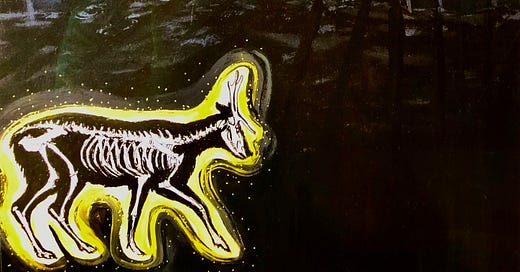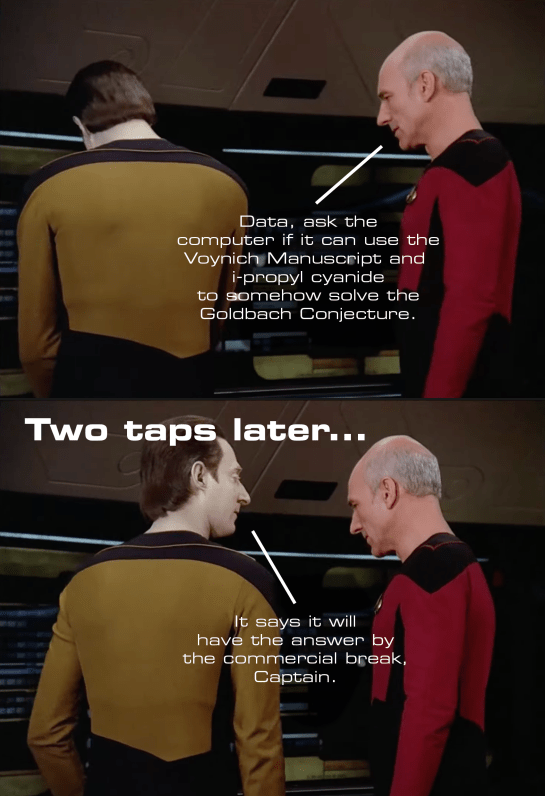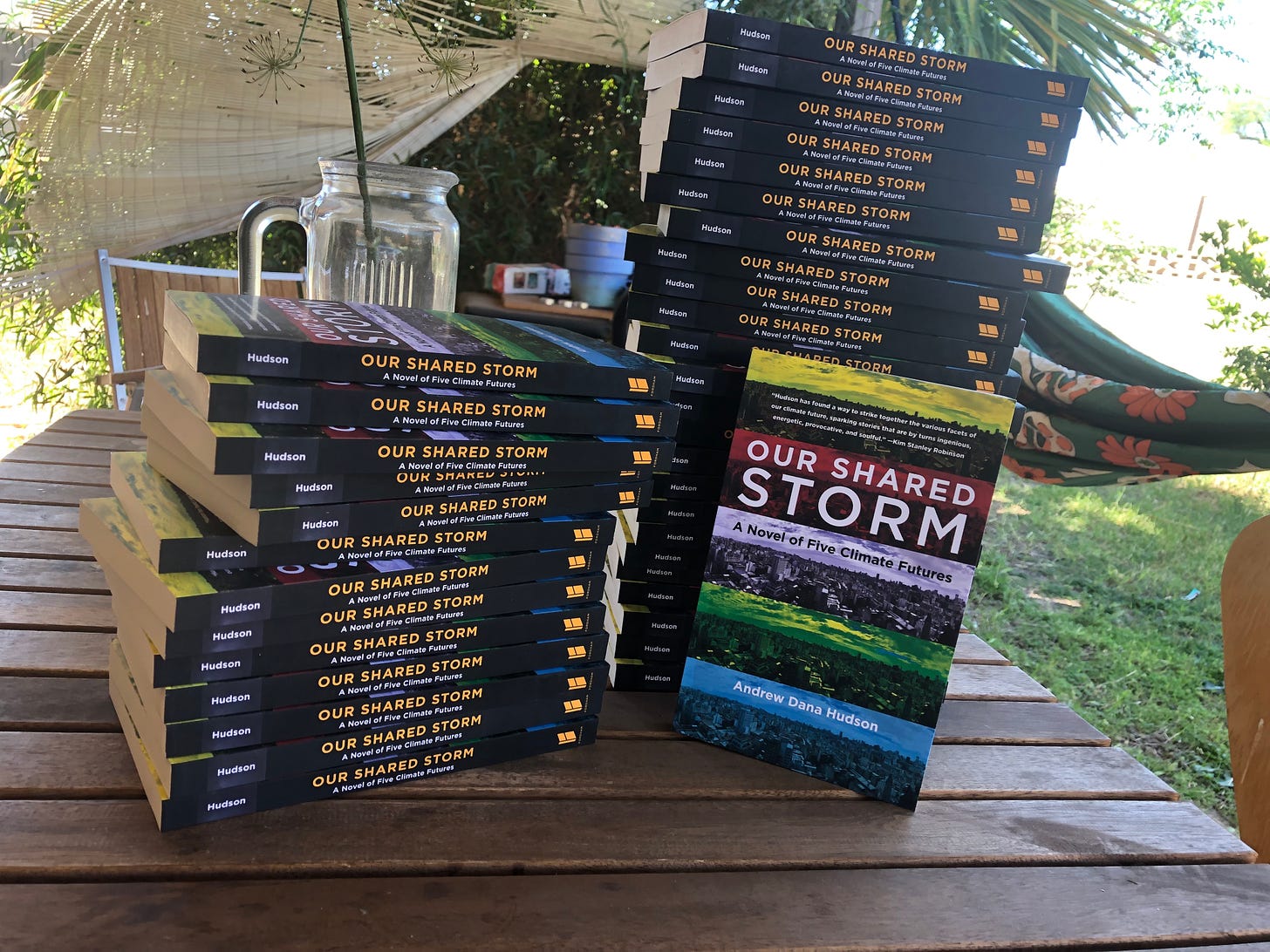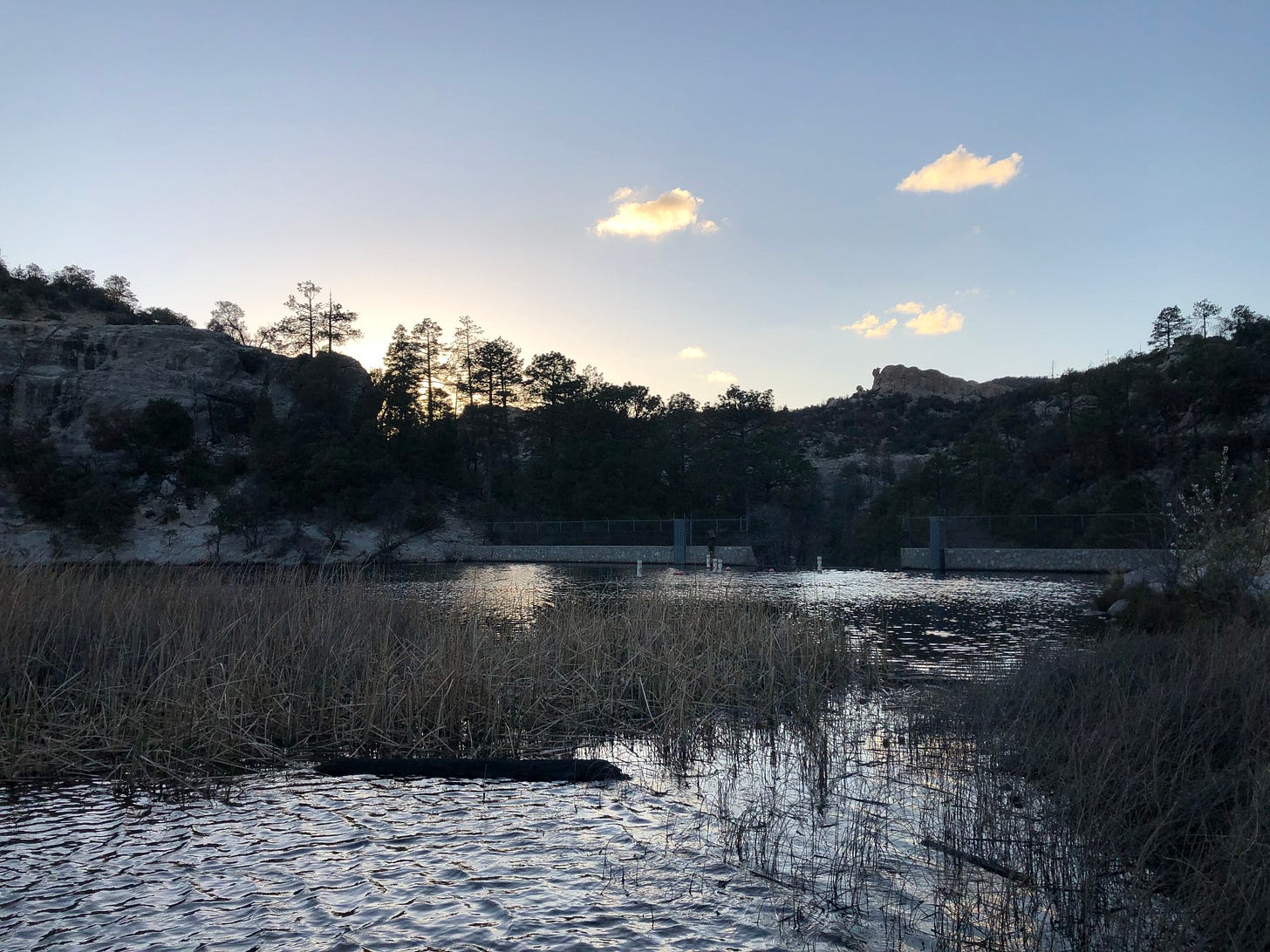A Blog Post About Star Trek
Through much of March, C and I watched episodes of Star Trek: The Next Generation in mostly random order. We just wanted a 40-minute show to eat lunch to, that was watchable without the attention requirements of Peak TV. While I’ve seen plenty of Trek in my life, it had been a while since I’d done a deep dive or considered it as a piece of science fiction. Like all SF, Star Trek choses to play by some rules of reality and not others, and to world-build around some of those choices but not all. Mostly TNG is great on this score, but one thing kept bugging me: the impossible speed at which the bridge crew occasionally carried out Picard’s more…complicated orders.
So I turned to my friend Chris Noessel, who (among other things) runs the excellent blog Sci-Fi TV Interfaces, which examines the ways futuristic technology is depicted in shows and movies. I figured Chris had already done a deep-dive into my question, but it turns out he hadn’t. So I wrote a little essay examining the question of super-human computer use in Star Trek——and what it implies about design and our relationship with AI.
My conclusion? TNG’s militarized space communism is only possible with the help of AI listening to your every word and making helpful suggestions about what it looks like you are trying to do. Kind of like a certain much maligned animated paperclip…
Anyway, Chris was kind enough to publish it as a guest blog, which you can read here: Make It So: The Clippy Theory of Star Trek Action.
Our Shared Storm Is Out Now!
My book——my first in English and the first one I am calling a novel——is now officially out. You can find the paperback on pretty much all bookselling websites, or order it via your local indie or not so indie bookstore, which helps bring it to the attention of bookbuyers. It’s also available on a variety of ebook platforms (Kindle, Nook, Google Play, Apple Books, Kobo). If you order paperback through my publisher, you can get 30% off with the code STORM30.
Thank you to everyone who has already bought a copy and who helped hype me up during my pub week! If you like what you read, or just want to help me out, please leave a rating or review on Goodreads or any of those platforms above. And feel free to drop me a line if you have thoughts about the book. One of the funny things about publishing a book is that, despite being written for public consumption, the author has to wait a long time to find out what anyone other than friends and editors think. So please: let me know!
Places I’ll Be
Washington D.C., Thursday, April 28, 12pm EDT, ASU Center for Science, Policy, and Outcomes
Phoenix, Friday, April 29, 7pm AZ, Changing Hands PHX
Tucson, Saturday, May 14, 1pm AZ, Revolutionary Grounds
St. Louis, Saturday, June 18, 2pm CDT, The Book House
Press Clips, Reviews, Podcasts, Etc.
Tor.com included Our Shared Storm in their monthly list of new sci-fi releases, serendipitously at the top. Being on a book list with Janelle Monáe was not on my bingo card for this year but I'll certainly take it!
I was interviewed recently on the lovely podcast If This Goes On (Don't Panic)! We chatted about my book, solarpunk, strategies for addressing the polycrisis, and plenty else. Give it a listen!
My friends at the excellent Nothing Here once again had me join their newslettering collective as a guest editor this week. We discussed climate politics, the epistemological crisis, and whether or not fungi can tell jokes.
Art Collection
I got this at Phoenix First Friday, after a long night of Arizona for Bernie tabling. I have no idea who the artist is, and it’s too tightly matted to extract the print to look for a signature. Sorry artist! If you ever see this, please tell me who you are!
Material Reality
On Monday, following a very busy pub week, C and I drove down toward Tucson to camp and get away from it all. Sometimes you just need to see a tree! Along the way we stopped for a tour of Biosphere 2. I’d attended a conference there a few years back, but C had never been. It’s a fascinating place, with a deeply ambitious and also deeply human history. Really one of the great tales of Big Ideas bumping up against Material Reality.
I won’t recount the whole story here, but you should look it up. Steve Bannon was involved——it’s wild stuff. I just want to talk about the highlight of the tour: a trip into the bowels of the facility to see “The Lung.” Biosphere wasn’t just a greenhouse, you see. It was actually intended to be air tight. This presents a lot of unique problems. Most infamously, they almost ran out of oxygen due to the rapid growth of soil microbiome, whose O2 consumption hadn’t been taken into account in the designers’ calculations. They had to truck in extra oxygen to keep the Biospherians from dying, and they tried to cover it up, leading to media scorn and public mistrust.
The Lung, however, was a solution to a problem they did anticipate: namely that if it got too warm, the expanding air would threaten to blow out the very rigid glass windows. So to alleviate the structural stress caused by the changes in air pressure, they built an enormous rubbery diaphragm. The picture above really doesn’t convey the scale and weirdness of this space, nor the high-school-physics sublime of watching the ceiling slowly (but visibly) sink when the tour guide opens a door.
That visit was the highlight, because the rest of the trip was a bit of a disaster. Though it is now reaching into the 90s here in The Valley, our campground in the Coronado National Forest was at 7000 feet of elevation. So it was cold, and extremely windy. It was also beautiful——a lovely little lake a short walk from our site——and basically empty. Like a lot of Arizona, the area around Mount Lemmon features dozens of rock formations that would be the prize jewels of national parks in other states.
We settled in for the night fine, but come morning the cold really got to us. By the time we’d cooked breakfast, C was almost feeling hibernatory, or possibly a smidge hypothermic. Eventually we decided to pull the plug and head out.
On the drive back down the mountain, however, I whiffed an odd, sickly smell in the car. We pulled over at a scenic overlook, and I rummaged around until I found the little canister of propane we used as cooking fuel. It was letting off an irregular but tell-tale hiss.
So we took the canister out of the car and freaked out a little bit. We figured something had gone wrong with the valve when we screwed on one single-burner camping stove. It was leaking at a steady pace, but we had no way of calculating how long it would take to be empty and safe. Our phones had no signal, and the instructions and warnings on the canister were conspicuously unhelpful about what to do about a leak. Certainly we didn’t want to bring it back into the car, even with the windows down. At this point we were even wondering if C’s odd lethargy might have been a small dose of carbon monoxide poisoning instead of mild hypothermia, or just bad vibes.
In the end we left the canister at the overlook, drove down the mountain until we hit another campground, and told the camp host about our problem. He was calm and copacetic about it, told us he’d drive up and take care of it. By the time we got into Tucson and ate a pizza, C was feeling better. But we felt very lucky indeed that I listened to my nose and checked on the smell. An unchecked propane leak inside our car could have gone much, much worse.
There’s probably some funny parallels to be drawn between our debacle and the problems Biosphere 2 faced. Doesn’t get much more Material Reality than running out of breathable air! But really, my takeaway was: fossil fuels suck. They’re dangerous not just to our planet but to our health. Just having a gas stove in your home has been linked to increased risks of childhood asthma and other respiratory illness. Our descendants will look back on our willingness to live surrounded by constant streams of explosive poisons with real horror.
I think this will be our last trip with that little burner. We already bring a solar panel and a battery generator with us camping, so I’m going to look into portable induction stoves (suggestions welcome). A small, angry act of decarbonization, but every bit does count.
P.S. and BTW
Next issue will be something a little different. Since it will go out on May 1st, I’m going to send out an unpublished short story, titled “May Day.” It’s one of my favorite things I’ve ever written, and I’m stoked to share it with my loyal newsletter subscribers! I guarantee you’ve never read a time loop story like this one.









